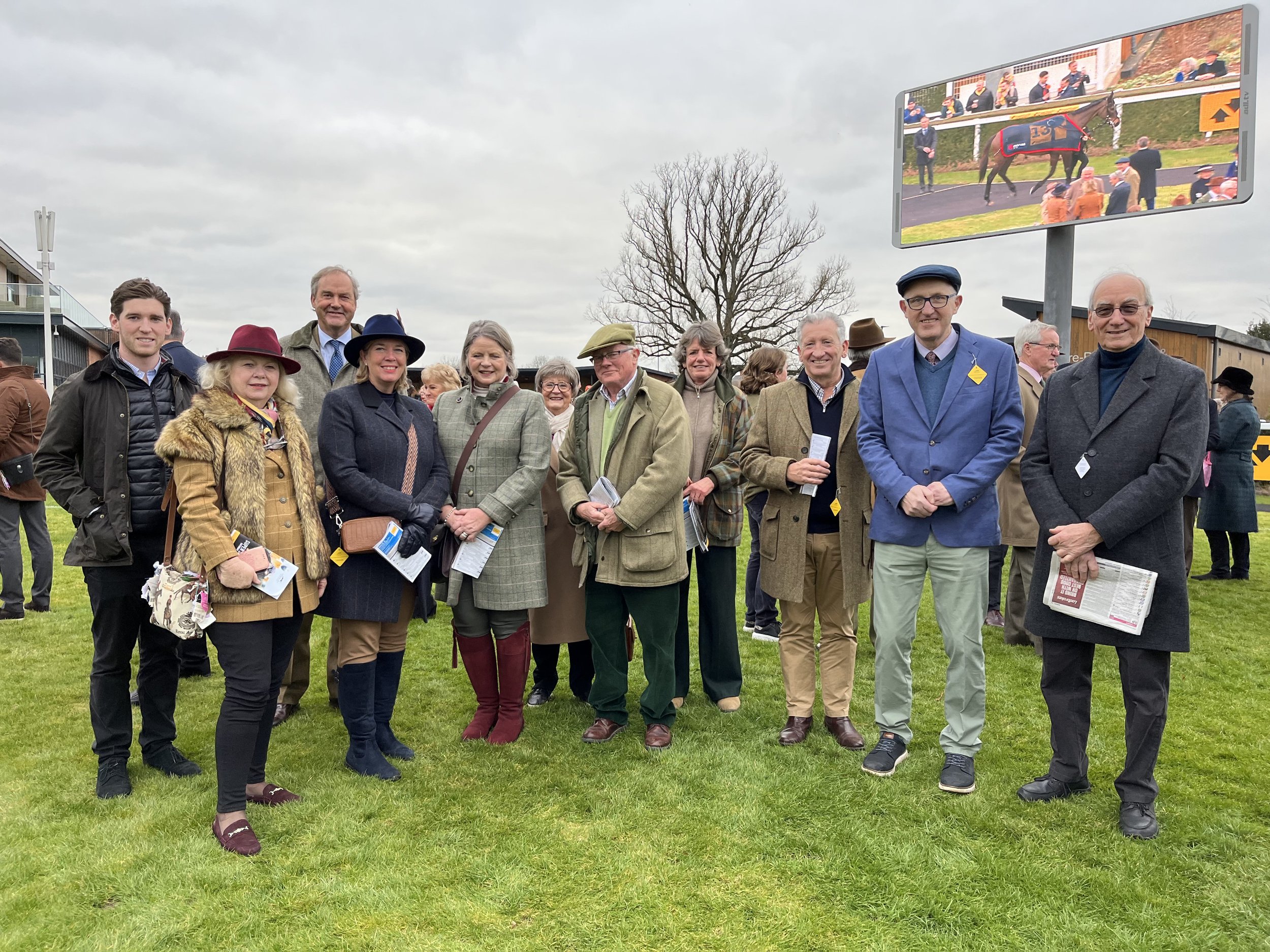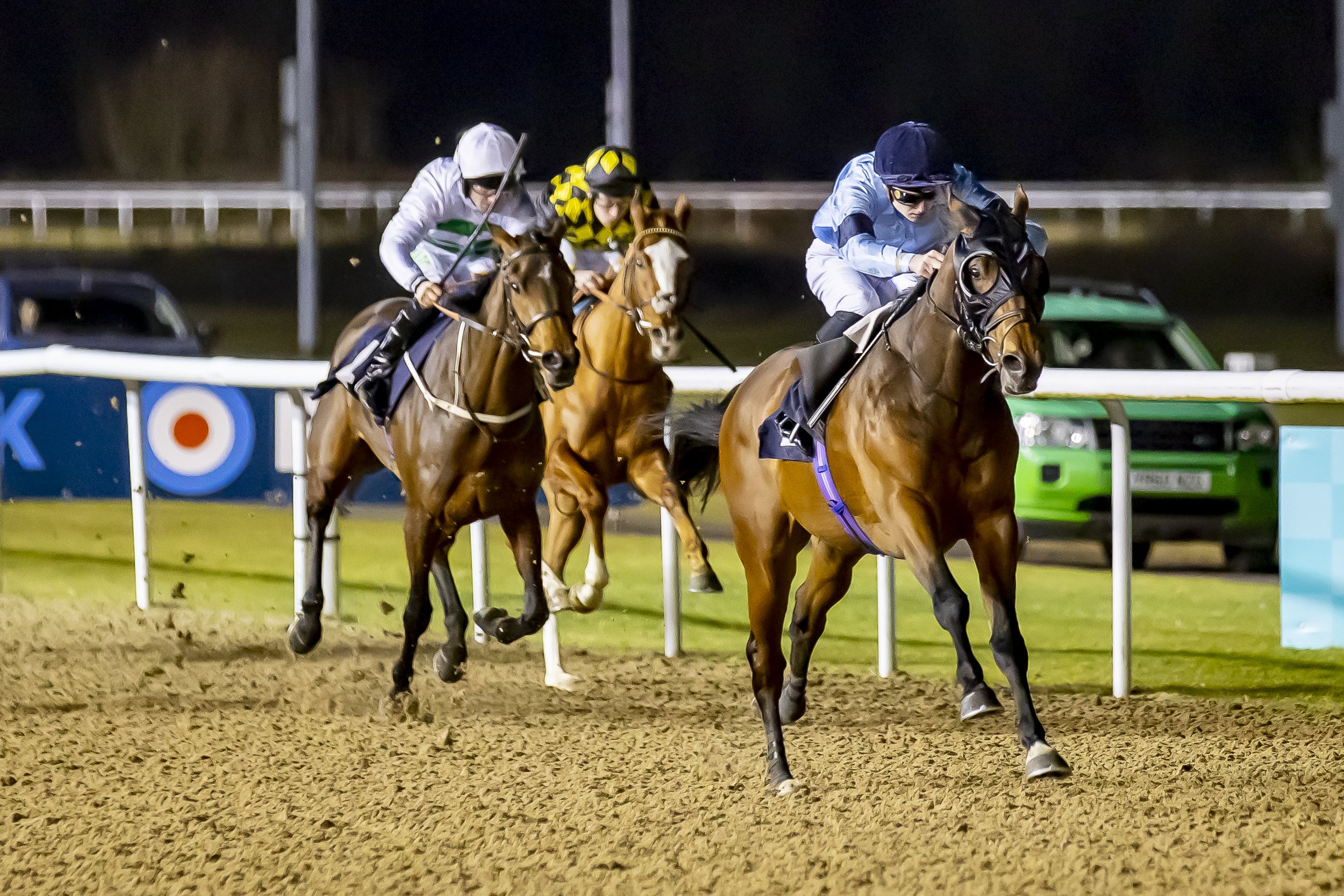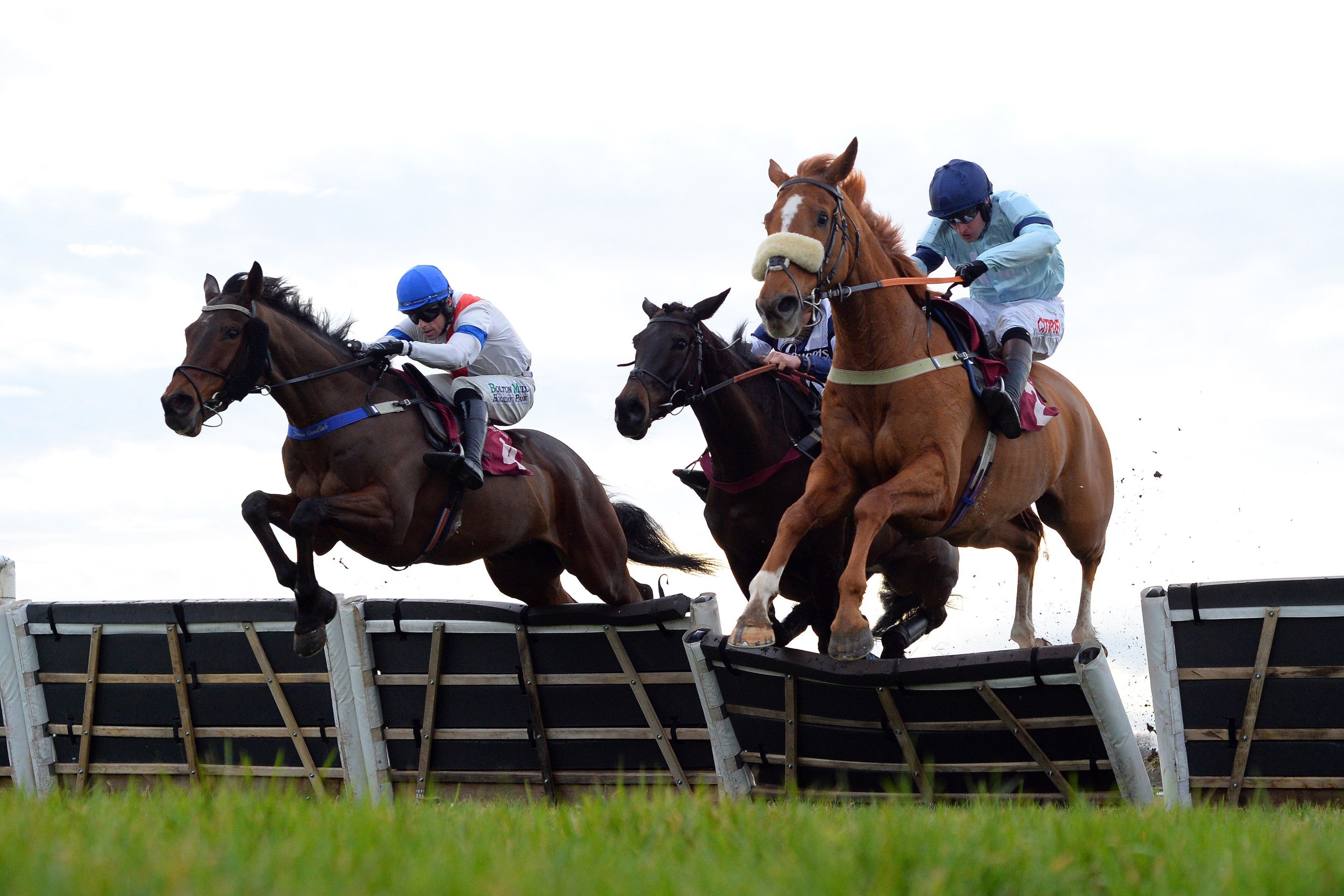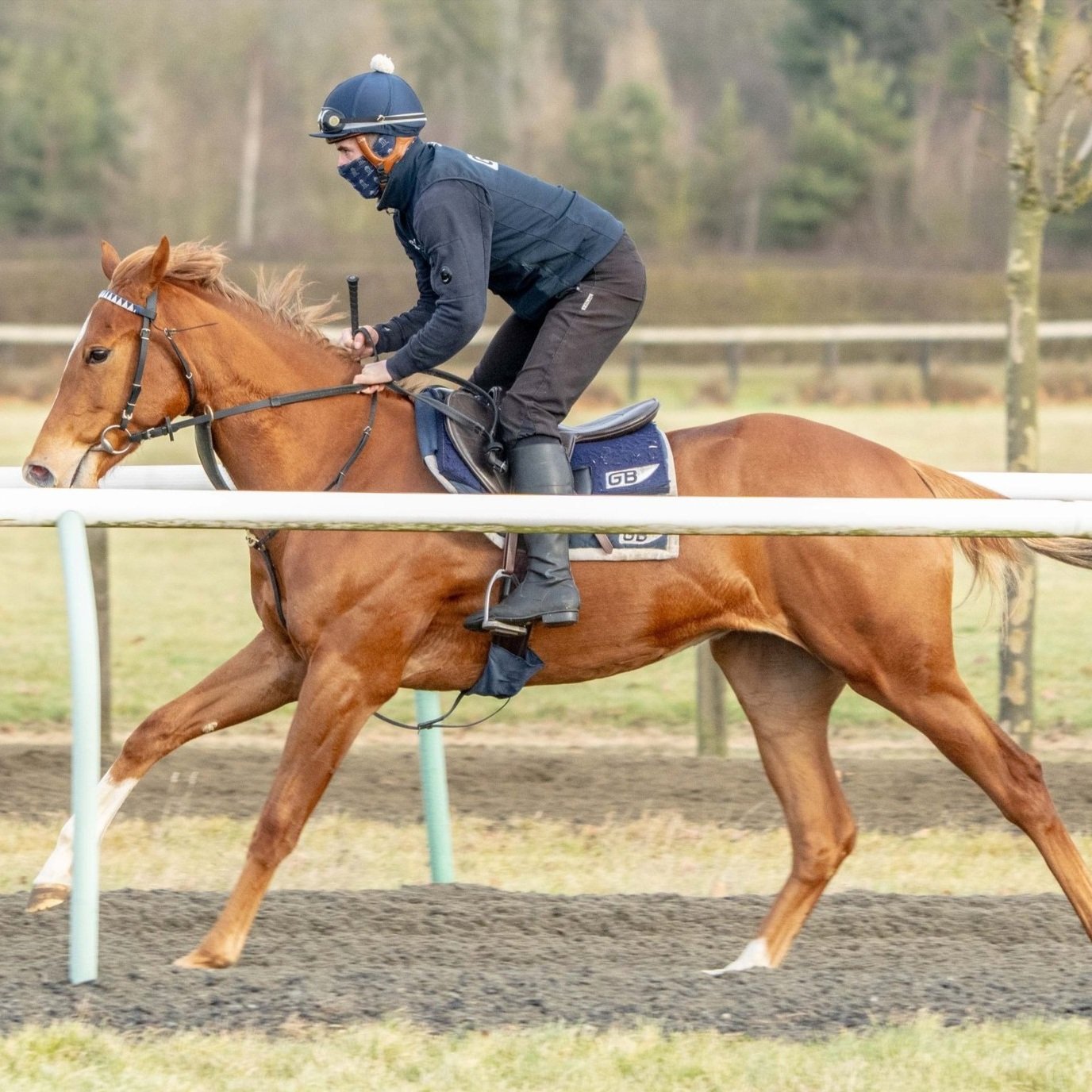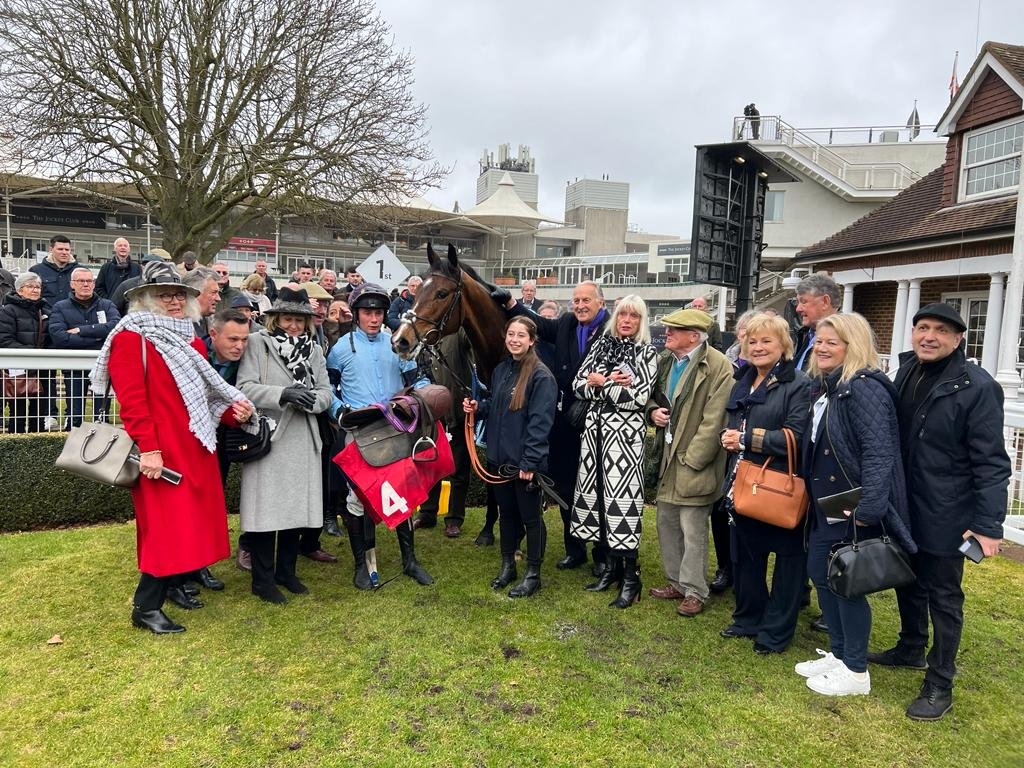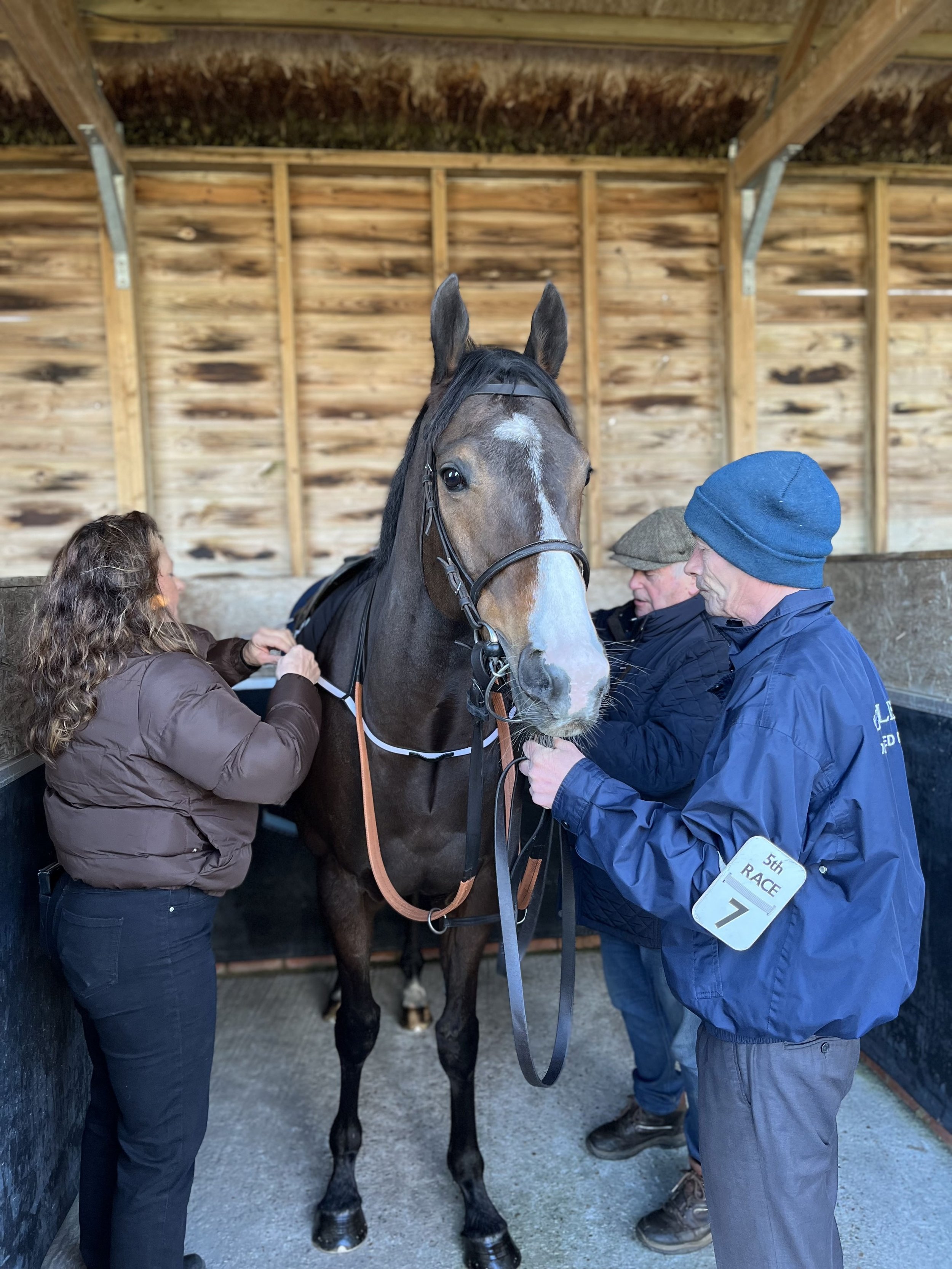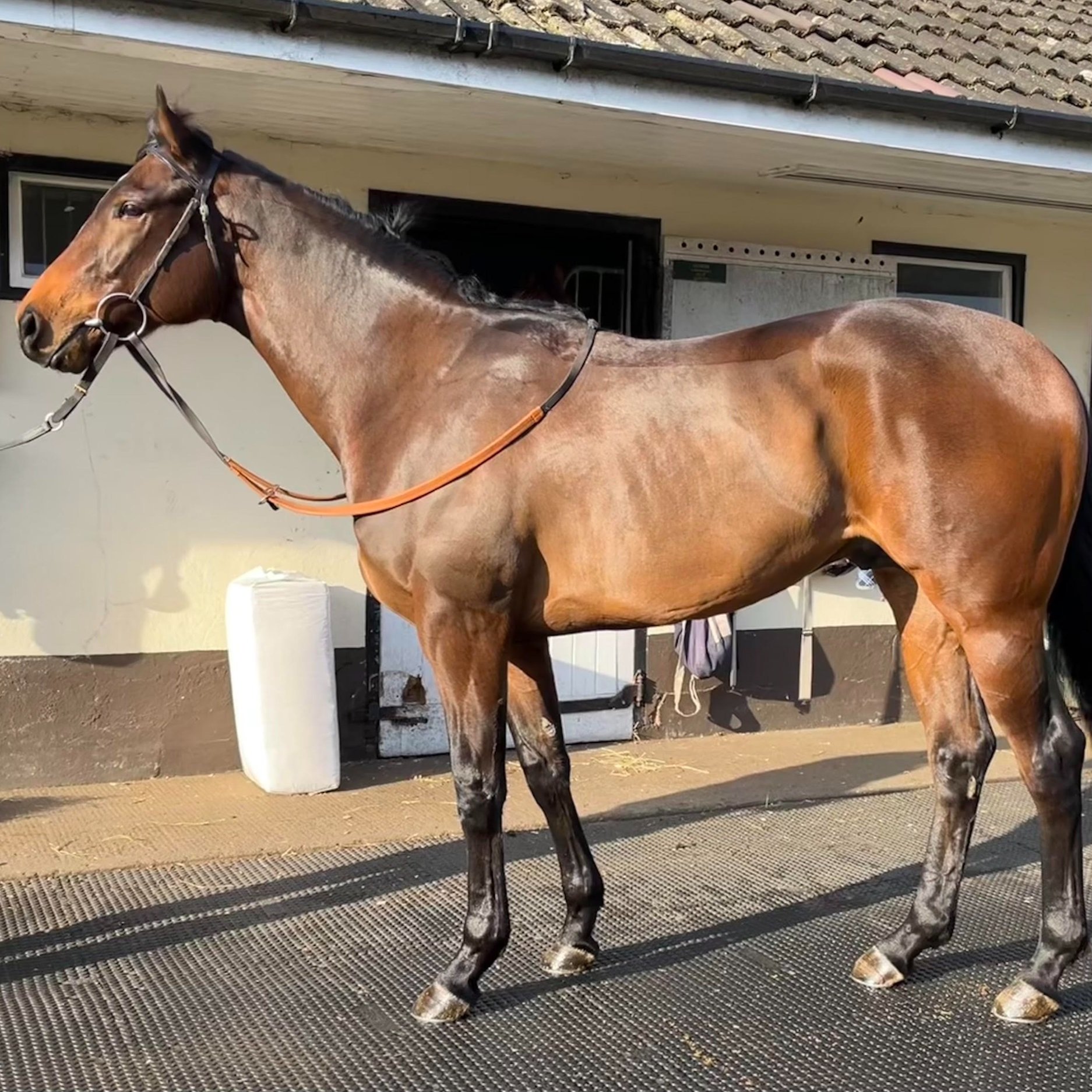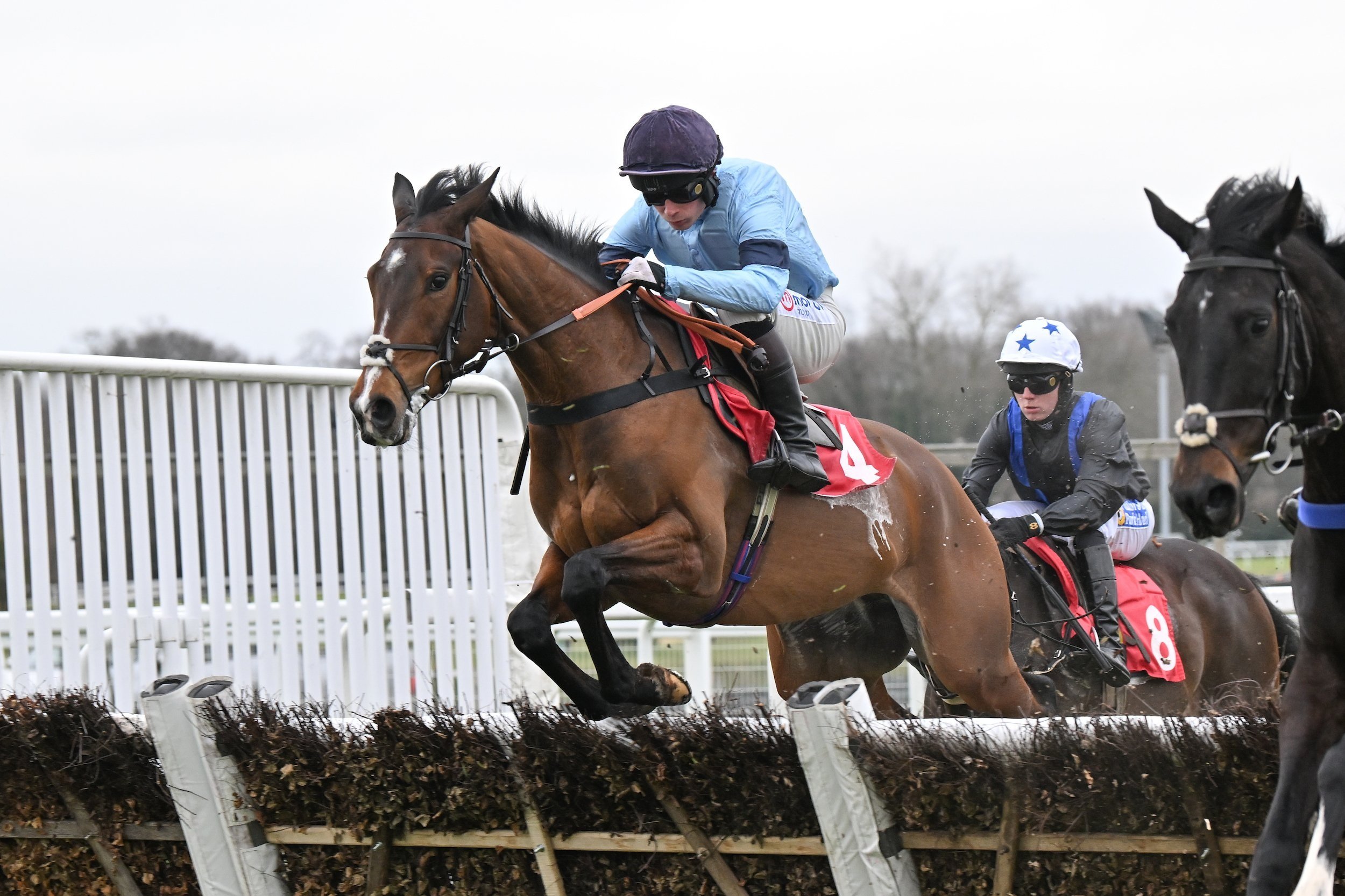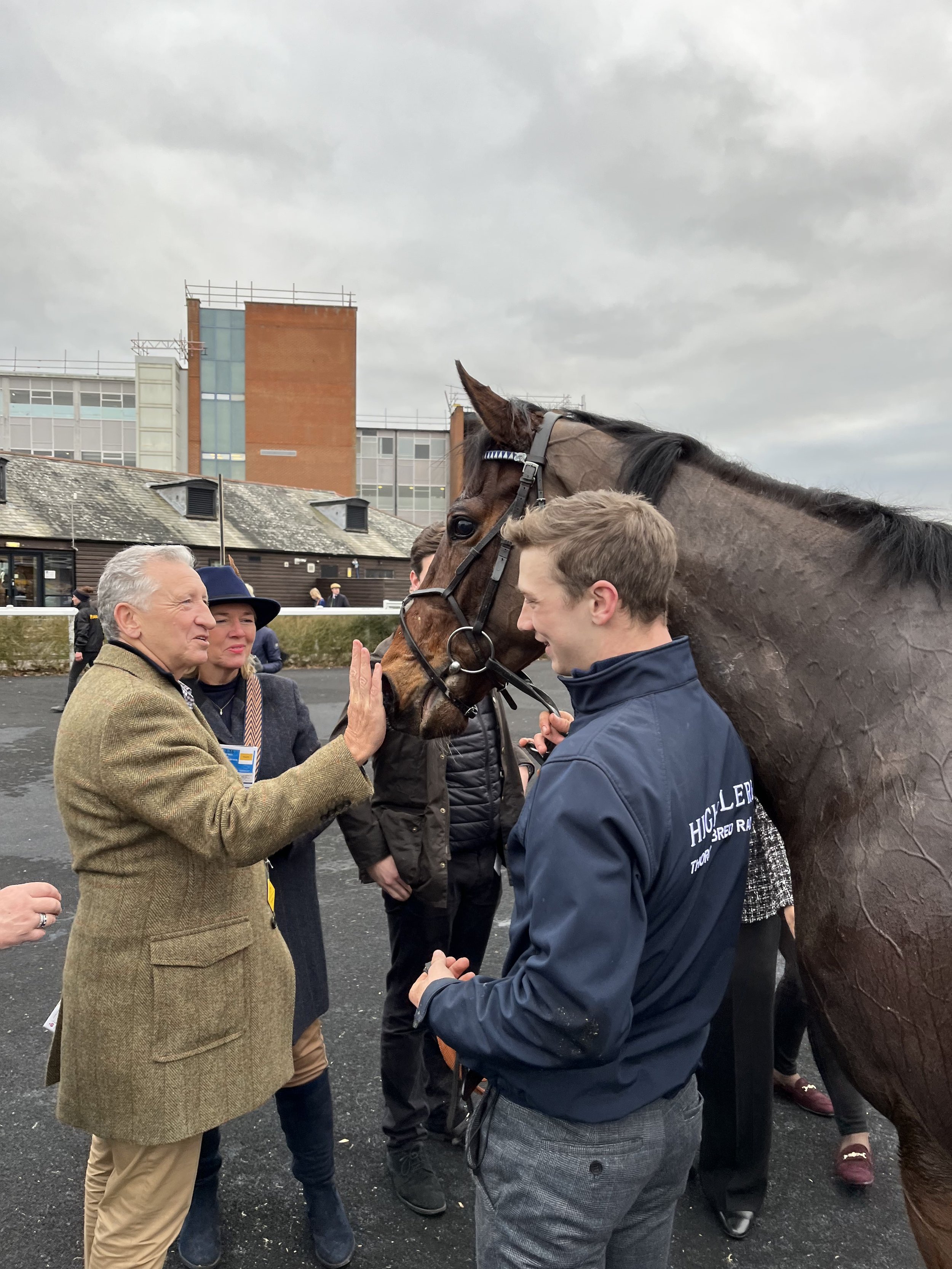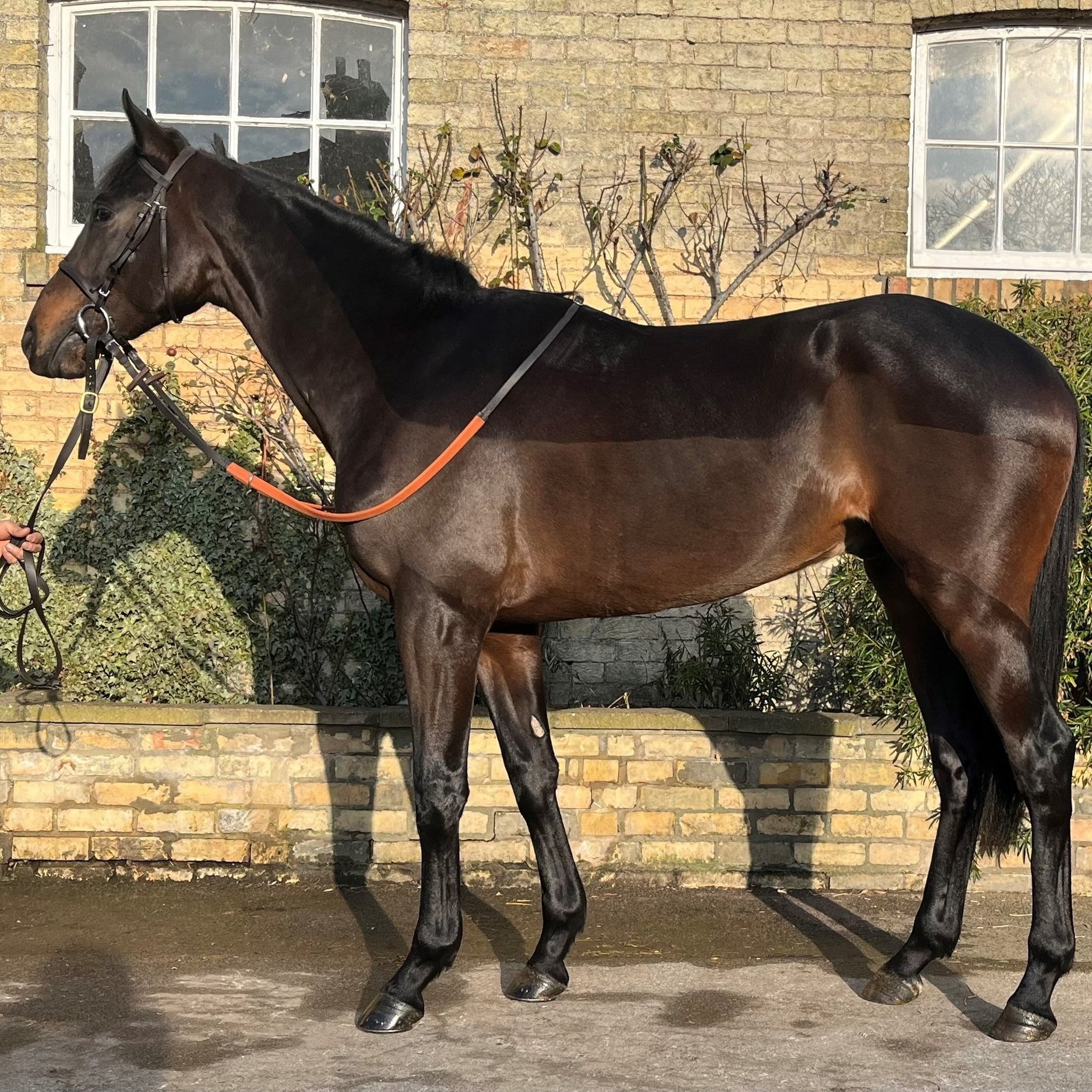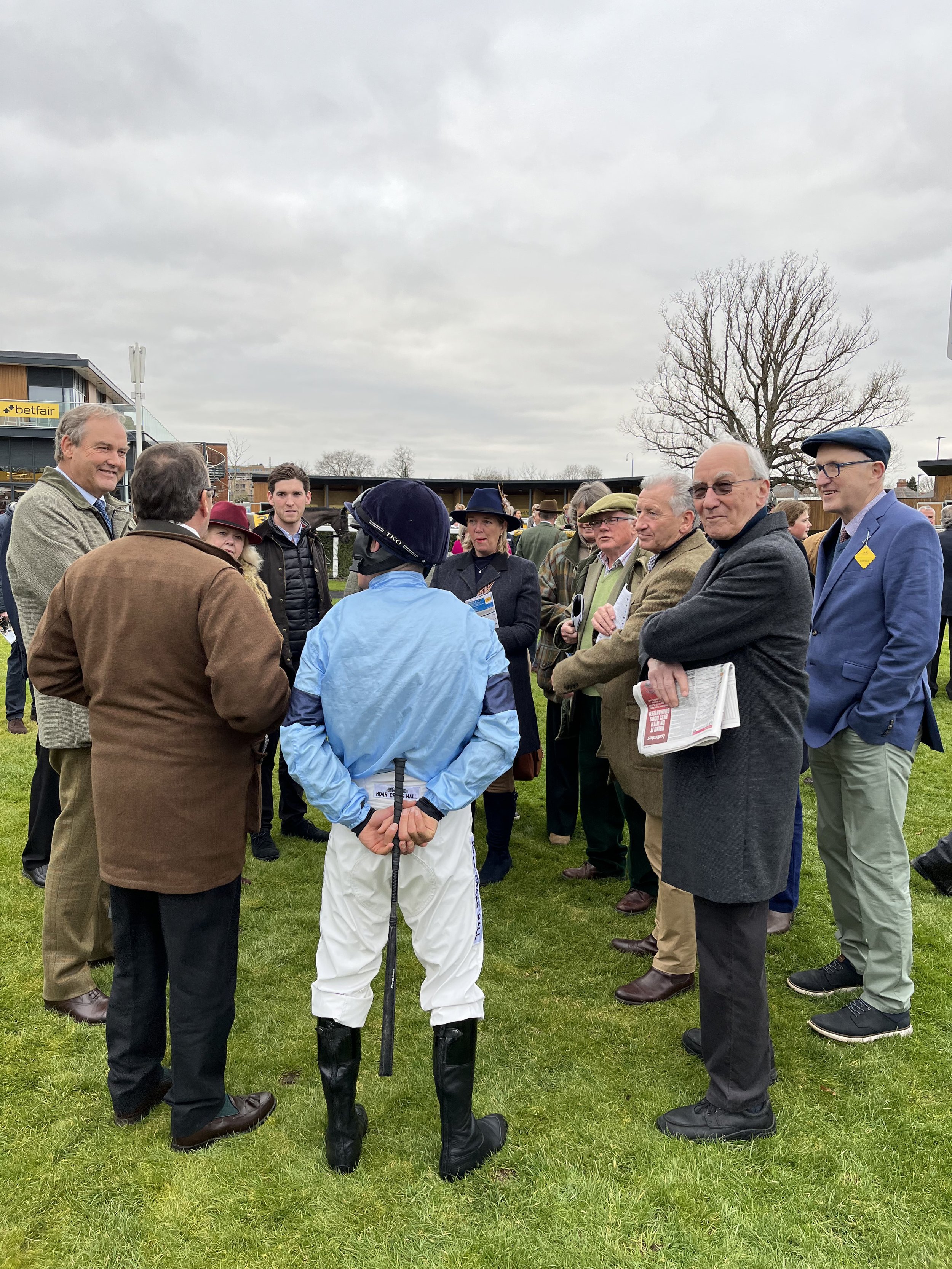FEBRUARY 2023
Winning connections with Beau Balko at Sandown
By Harry Herbert
I was up in Newmarket with Emily and Frances last week and I’m still buzzing with excitement for the season ahead! Remarkably we enjoyed lovely weather, the horses were all moving beautifully, and they looked terrific skin wise. After all these years I still get such a thrill seeing how they have all changed - whether it’s the two year olds learning their trade or the older horses reaching full maturity. With some of the three year olds it’s so easy to see why they didn’t race at two as they bear little resemblance to the horse we watched a year ago! Some of ours that fall into that category are Charitable (Andrew Balding), Reflex (Charlie Fellowes), Indemnity (Roger Varian), Truthful (William Haggas) and Tribute (Ed and Simon Crisford). These five are well worth following so put a marker by their names when considering your choices for the Five to Follow competition! Of those that have raced I would say that Hectic (Richard Hannon Jnr) would be right up there as one that looks so different from his two year old days. A winner on his debut at Newbury he didn’t really build on that and then rather lost his action so we gelded him and sent him off to Brian O’Rourke for some winter TLC. Brian as usual worked his magic and Hectic is about to head back to Herridge and is another who could have a big season ahead.
Hectic winning in July 2022
Cachet, our star QIPCO 1,000 Guineas winner, is back cantering and is looking fabulous. She will probably be aimed at the Chartwell Stakes (Gr 3) at Lingfield over 7f for her four year old debut. Of George‘s other Highclere horses I thought that the listed winner Proverb had done very well and looked the best of all in his coat. He must be on the short list for the competition and his plan is to head to Chantilly for the Listed Prix Ronde de Nuit. All of William Haggas’s horses look a picture and he has already got us off the mark with Ramensky storming to a facile victory at Wolverhampton recently. It looks as though gelding has transformed this horse and he could follow up shortly in another valuable all weather handicap. Of William’s other Highclere horses I thought that Sea Eagle looked a stand out. He too has been gelded and just might be a Brittania horse in the making. Our highest rated horse with William, Lysander, who finished third in the King Edward (Gr 2) at Royal Ascot sadly suffered a set back and so he won’t be seen until we are into the second half of the season. Roger Varian’s horses look marvellous. I have already mentioned the unraced Indemnity but another to watch out for is Eximious who won impressively at Salisbury last season but ran inexplicably badly at Newmarket in a group race at the end of the season. She is way better than that and should be followed this season.
Western - more info here
Of the two year olds amongst the most precocious would be the Richard Hannon trained Western who is finding it all very easy. We do have a share available in him so do check him out if you want some early action. Defiance (Roger Varian)is by Camelot so you wouldn’t expect him to be early but looking at him power up Warren Hill last week doing two canters he just could be a June/early July starter. Drama (James Ferguson) is a ready made two year old and despite having to have a growth removed from his foot is about to be ridden again. Being by Havana Grey, last years champion first season sire, this inexpensive colt has the pedigree and physical profile of a possible Royal Ascot performer if good enough! Mannerism (Karl Burke) is by Caravaggio and is out of a Galileo mare. Despite being a well grown colt he really covers the ground but as with so many of that Scat Daddy sire line they bely their size and can run much earlier than you might first think. I believe that this colt will be a summer two year old and he is certainly doing everything right! We do have a share available in him so definitely stop and take a close look! He is a “corker”!!! Both Quantum Force (George Boughey) and Pianoforte (Andrew Balding) are by first season sire Land Force who stands at Highclere. The chat on Land Force’s first crop is very good with the breeze up boys telling Jake that they love what they see and believe me they would know! Our two are cracking individuals and we do have a couple of shares available in each so, again, take a close look at them. Quantum Force is part of a two horse syndicate with Nicolas Clement in Chantilly training the other animal, a beautiful filly called Tonight by first season sire Waldgeist. Pianoforte is eligible for the Goffs Million worth a cool €500,000 to the winner!
There are many others but this should whet the appetite as the daffodils come up and that first turf meeting at Doncaster gets ever closer!
With my best wishes,
Harry Herbert, Chairman
Taittinger Moment
Helen Yeadon of Greatwood
By Emily Scott
This month’s Taittinger Moment has been presented to Helen Yeadon. Helen runs Greatwood, a fantastic charity that uses former racehorses to educate disadvantaged children and young adults with Special Educational Needs. This year marks the 30th Anniversary since Helen started her work and 25 years since Greatwood has been a registered charity. Highclere owners have been supporting Greatwood for over 15 years through our annual 5 to Follow competition. With a stake of just £25 per entry I would encourage you to get involved to support a great cause and also be in with a chance of winning a Methuselah of Taittinger! The 5 to Follow competition details will be sent out next month with the Highclere Horses In Training card. Entries must be submitted (by post or email) before the turf season commences on Saturday 1st April.
On The Track
Lime Avenue towers over her owners in the winner’s enclosure at Wincanton
By Frances Howard
We have enjoyed a 50% strike rate on the track this month – with 5 winners from 10 runners. Lime Avenue kicked off proceedings with a highly impressive victory at Wincanton on her third attempt over obstacles. We knew the engine was there following her eye watering bumper performance at Chepstow back in the Autumn, but her first two runs over timber were underwhelming for various reasons. The Champion trainer worked his magic however, and turned her out at his local track where she bounced right back to form with a dazzling display in the mares maiden hurdle. She is a really exciting prospect and she will no doubt receive plenty of support from her shareowners at Newbury next month when she will be lining up in the £50,000 mares final.
Lime Avenue on her way to an impressive win at Wincanton
The Nicky Richards trained Snowy Clouds made it 2/3 over fences with another foot perfect front-running performance. He never saw a rival in the 2m handicap chase at Catterick, where good ground once again proved the key, and won hard held by 16L.
Snowy Clouds flying over the last in splendid isolation at Catterick
Horacio Apple’s hurdles form now reads 3,3,1,1, - the Guerriero/Greenall team stepped him up in trip at Bangor where he produced an absolute thriller, just getting up in the dying strides to win by a head. He is another progressive type who is very much learning on the job and is sure to keep improving.
Horacio Apple’s fends off a strong challenge over the last to win cosily at Bangor
Attentions then turned to the flat where our first runner of 2023 was a winner. Ramensky returned to William Haggas a much mentally and physically mature 3yo and we were hopeful therefore that he might improve on his three promising last season runs. He did just that at Wolverhampton earlier this month where he powered clear of rivals to an impressive 4L victory in a 1m4f novice event.
Ramensky storming clear at Wolverhampton under Adam Farragher (3)
Beau Balko yet another youngster on an upward trajectory – more than made amends for an out of character flop at Taunton, when bolting up at Sandown in a 2m conditional jockeys handicap hurdle last week. That was his second victory over timber and whilst the handicapper hasn’t let him off lightly, trainer Paul Nicholls is confident that there is plenty more to come from him and his target is now the £100,000 novice handicap final at Sandown at the end of April.
Beau Balko en route to an impressive victory under Angus Cheleda (3)
Rolf’s Rambling’s
By Rolf Johnson
In the January Newsletter we examined the history of handicapping. Though the first handicap took place at Ascot in 1790 it was Admiral Rous in the nineteenth century who established a form of racing which dominates, through betting, our sport. Various trainers have been anointed “Handicap Kings” – not always intended as a compliment. Few practitioners express their opinions on the topic as forcibly or as forensically as Mark Johnston. Already well ahead of any other trainer in the ‘numbers game’ when his five thousandth winner weighed in last year, in recent successive editions of his Kingsley Klarion house magazine Mark, since taking a back seat, stripped handicapping of its mystique – or has he?
Elected for a second time in 1959 Prime Minister Harold Macmillan announced: “The class war is over” - and proceeded to appoint four Lords to his Cabinet. In 1997 new PM Tony Blair, net worth £50.3m, proclaimed, “We are all middle class now.”
The indefinable ‘class’ word, as in ‘class acts’, is used as promiscuously in sport as in politics. Like many another word in the lexicon – reading and Reading for instance; “handicappers” for “punters” in America - class is a word ripe for misinterpretation and the crutch of many a cliché: “Class is permanent, form is transitory”: “greatness is earned, class bestowed”. Failing to recognise ‘class’ is akin to saying you couldn’t pick your wife out in an identity parade of loose women.
In their empirical study ‘Guide to the Classics’ (1939) sub-titled ‘How to Pick the Derby Winner’ the laudable aim of Oxbridge philosophers Michael Oakeshott and Guy Griffith was to take nebulous ‘class’ clouds out of calculations. And yet even this distinguished academic duo nod to the notion. “The student who leaps to the conclusion that any high-class handicapper can get a Derby winner will have to repent of his folly and mend his ways.”
Frankel was commonly referred to as ‘different class’– perish the thought he was ever considered for a handicap: his achievements cannot be reduced to mere figures. Just twice in his fourteen-race career he was threatened. On his two-year-old debut in August 2010 Nathaniel gave him a fright, Frankel emerging 1lb superior. Nathaniel was then rated 91. The next year, in their St James’s Palace clash at Royal Ascot, Frankel just held Zoffany, who achieved a top rating of 115. Frankel never dipped below 123: he ascended to 140. Neither class nor form sheds light on those scares by excellent but lesser rivals.
American phenomenon Flightline has just been rated Frankel’s equal – over to bar stool nerds. Official international ratings began in 1977, designed to assess current performers and compare them with champions of the past. Bizarre examples abound: Three Troikas (137) rated 1lb superior to Sea The Stars? I think not. There has been much ‘tinkering’ (gerrymandering?). Dancing Brave’s 141, the 140s of Alleged and Shergar were horses of another era. If the thoroughbred is improving can we say the aforementioned rank alongside Frankel and now Flightline? The latter won all his six races by six lengths and more, on dirt: Frankel’s were on turf. Those surfaces are as foreign to one another as the ones on which human athletes stamp their greatness: on ‘cinder’ tracks (made from London debris created by German bombs) think Roger Bannister; on modern surfaces (rubber crumb and polyurethane) think Usain Bolt. Incomparables.
So class means what the perpetrator wants it to mean. Mark Johnston aims to demystify handicapping and the class factor. The fabled all-time winning-most trainer before handing over (the limelight) this year to his son Charlie, discusses handicapping in the Klarion under the headings “The Weight Myth” (issue 327, Dec 2022) and “The Science of Handicapping?” (328, Jan 2023). (That whopping question mark is a giveaway).
Mark states (327): “It seems to me that the class of opposition is far more important than the actual slowing effect of any weight burden...why would weight have the same effect on all horses?” The self-confessed provocateur and contrarian then concedes: “I am a great believer in using official handicap ratings to assess the strength of races…Handicapping is important because the majority of horses…will be stuck in the handicap system…If I am to place horses well I must always be very conscious of their handicap rating.”
Admiral Rous (1795-1877), first and last ‘Dictator of the Turf’, must take the blame for the handicap structure which buttresses racing. But our partiality is waning. Modern bettor’s appetites are insatiable for ubiquitous football and ‘sexy’ wham bam cricket. Studying racing form by contrast is a Timeless Test (they disappeared in 1939 in South Africa when an interminable game was abandoned – just in time for the England team to catch the last boat home).
The imperious Admiral provokes Mark (no shrinking violet) into denying handicapping the title “science”.
“Amazingly,” says Mark, “his (Rous’s) theories and calculations have hardly been questioned, never mind changed. Indeed, he regards the Admiral’s calculations as no more than “a bit of basic arithmetic...I intend to call into question the objectivity of handicapping through the allocation of ratings by individuals” citing the example of Trojan Spirit clobbered by the handicapper on his first run for Charlie Johnston. “If the arithmetical rules of handicapping (were applied to Trojan Spirit) it would expose the whole system for the dog’s dinner that it is.”
But it’s a dog’s dinner that the trainer lapped up in his time. Mark’s iconoclasm is written across his default countenance – wry amusement – laminated with intimidating opinions and Charlie is obviously a chip off the block. Take his immediate New Year victory with Timewave, a three-year-old, bottom weight in his first handicap, Class 5, having previously beaten one horse in three outings to earn a meagre handicap mark of 59. Longer trip, gelded, Timewave ‘made all’ at Kempton. Sir Mark Prescott, virtuoso of the handicap system, had best look to his laurels. Mark Johnston in Klarion 328: “The handicap system…commonly results in horses which are lucky” (is that Sir Mark coughing?) “enough to enter on a low mark or, dare I say, had their entry rating manipulated.” (Sir Mark spluttering?).
Although Johnston Snr would surely have swapped some of his handicap triumphs for more regular Classic victories his argument that handicapping is “an anarchic anachronism” is best illustrated by his mare Scatter Dice. Beaten twenty times in 2012-13, off only a 1lb higher mark than in her previous, distant victory, she landed her swansong, the ultra-competitive Cesarewitch, at 66-1, in a complete canter: Richter scale tremors were recorded in Kensal Green where Rous is buried. Yet my own, late, official handicapper amigo would have taken satisfaction in such a result. His brief was not to produce triple dead-heats – so called ‘triumphs for the handicapper’ - but to adjust ratings so that the betting market remained as open as humanly possible. Try laying down the ‘laws’ of handicapping for a Johnston a Prescott or a Pipe.
Mark’s conviction is that constant speed is the route to maximum performance and it isn’t jealousy that prompts him to rely on the example of the “fuel consumption gauge in my father-in-law’s BMW” to establish what is “in the tank” of a racehorse rather than following down Pipe’s singular revolutionary training road. Mark wasn’t original in using the titillating analogy ‘more pistons, more power’ but until we have plug-in electric racehorses (or hybrids!), personally I’ll remain a dedicated disciple of Pipe’s sacerdotal powers. Who can forget his Unsinkable Boxer destroying the handicap for the 24-runner Pertemps Hurdle at the 1998 Cheltenham Festival? Tony McCoy’s instructions from MCP were irrefutable: “This is the biggest certainty that will ever walk out onto this racecourse”: bigger than Scatter Dice.
An award winning sportswriter wrote the acclaimed, The Meaning of Sport (2006), without mentioning class: an oversight, possibly but the word was not in Rous’s vocabulary either. Nor in that of arguably the greatest of all breeders, Federico Tesio (1869-1954) who insisted, “There is no way of measuring a certain distance at which speed ends and staying power begins” – which could be some advocate’s definition of ‘class’.
In his lifetime, and since, Rous’s esteem was built on the fruits of unquestioned hard study. In Issue 328 Mark demands a rethink. “Surely it is long past time for someone to question the principles of handicapping horses by adding weight. The handicapping system is mostly about grouping horses into races with others of similar ability” – and he might have added ‘purely for betting purposes’. Putting words in Mark Johnston’s mouth is akin to placing one’s head in the lion’s jaw but such thinking bonds him with my handicapper chum. Was class the deciding factor when Trueshan started favourite for the Northumberland Plate and confounded the handicapper (and nineteen rivals) under the welter weight of 10-8? Not in my book. Trueshan did win Group races – though not off as high a rating as he was raised, 4lb to 124, consequent on Newcastle. Leading stayer Kyprios, who beat Trueshan two lengths the only time they met, is also 124. Kyprios has never run in a handicap.
If you can’t aggregate, you can’t quantify and you’re left with conjecture. Better to study The Art of Always Being Right (1896) by the philosopher Arthur Schopenhauer. It can’t have been the intransigent Admiral Rous’s bedside reading because he died twenty years before publication, but he would surely have concurred with Schopenhauer’s sentiments - worth a glance before you argue the merits of handicapping.
Me, I’ll stick with the Form Book, according to Marks Johnston and Prescott – and of course, Martin Pipe.
Clodagh’s recipe of the month
TUSCAN VEGETABLE AND BEAN SOUP
By Clodagh McKenna
Hi everyone!
I hope you are all well, and enjoying the incredible season of snowdrops that we are having, isn’t is just a cheery sight! As lots of you already know I opened a new shop just 4 months ago in the courtyard of the beautiful Retreat at Elcot (just 5 minutes outside of Newbury). I launched a range of homemade delicious CLO TO GO meals just a couple of week ago – soups, pates, stews and ragu. So I thought I would share a recipe with you for my best selling soup! Hope you all enjoy it!
Oh and if anyone of you are interested in learning how to make breads, I am hosting an Irish Bread Cookery Demonstration at the Retreat at Elcot on Saturday 18th March at 10am. Booking is essential and places are limited. Here is a link for more details here
Hope to see some of you on the 18th!
Clodagh xx
TUSCAN VEGETABLE AND BEAN SOUP
Serves 6
INGREDIENTS:
3 tbsp olive oil
3 medium carrots, peeled, cut into cubes
2 celery stalks, cut into cubes
1 onion, peeled and diced
3 cloves garlic, crushed
600ml vegetable stock
2 x tins of cherry/chopped/plum tomatoes
1 can cannellini beans, rinsed and drained
1 can chickpea, rinsed and drained
250g kale, chopped
1 tsp dried chilli flakes
sea salt and freshly ground black pepper
METHOD:
1. Place a large saucepan or casserole dish over a low heat and pour in the 3 tbsp of olive oil. Then stir in the carrots, celery, onion, and garlic. Season with sea salt and freshly ground black pepper. Stir well, cover and allow to cook for 10 minutes, stirring every five minutes or so.
2. Then add the stock, tinned tomatoes, and cannellini beans to the soup
and cook for five minutes. Stir in the chopped chard or kale and chilli flakes - cook for a further 2/3 minutes.
Where are they now?
Burlington (left) and Beacon (right)
By Emily Scott
Highclere have two residents at Greatwood, Beacon and Burlington.
Beacon (11yo gelding by Paco Boy ex Key Light) was a superb juvenile for Highclere winning 4 of his 7 starts at two, including a record-breaking win in the Flying Childers (G2) at Doncaster. He is a yard favourite and personally adored by Helen who makes sure he is treated with carrots on a daily basis!
Burlington (8yo gelding by Zoffany ex Peig) was not so successful on the racecourse due to a deteriorating wind problem. He ran three times without placing and it was decided that it was kinder to retire him to Greatwood than put him through a sale. Burlington is quite a character and “extremely intelligent” according to his groom, who plans to do some show jumping with him this year to keep his mind occupied!
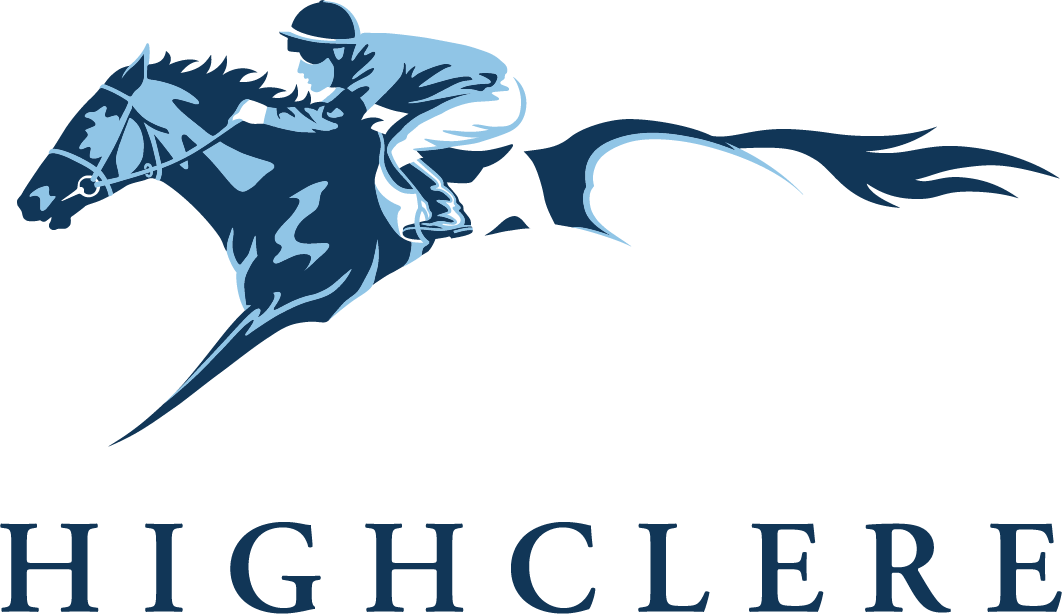












![Rolf[69].jpg](https://images.squarespace-cdn.com/content/v1/61f12359c76c4c234ba9a355/1671720372982-05Q1VND86OGEQX6N2E4W/Rolf%5B69%5D.jpg)


